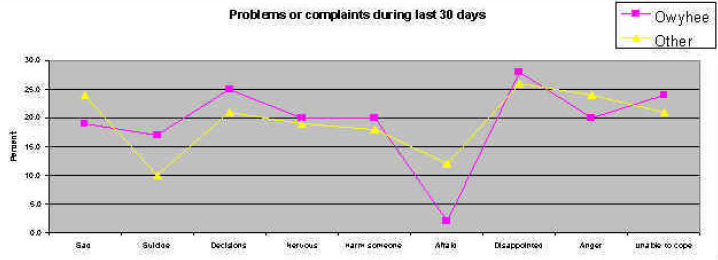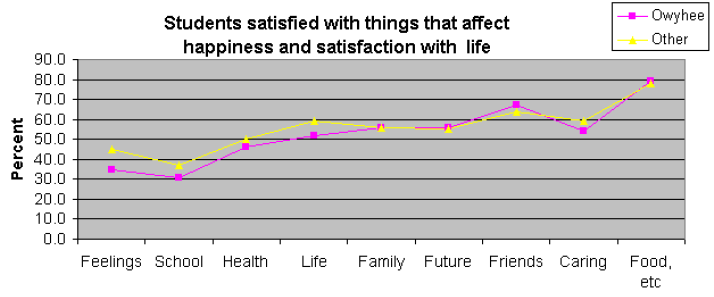Introduction
A fatal auto accident on the Duck Valley Indian Reservation in Northeastern Nevada last May 2000 involved three juveniles who were drinking and driving. This and several other alarming statistics have caused much discussion about the status of the Shoshone-Paiute youth that attend school in the isolated, rural community of Owyhee. A total of 1,818 enrolled tribal members reside on the reservation.
A few statistics about the area include:
- The unemployment rate is 60%. A tribal survey showed that most of the unemployed would like to work but there are no jobs available. The minimum commute of 200 round-trip miles a day for off-reservation employment is unreasonable for most people.
- Poverty is so pervasive that 95% of the youth in the Owyhee Combined School (which serves grades K- 12) are eligible for free or reduced lunch due to their families’ low income.
- On the Terra Nova standardized tests in core subjects given to 2nd through 10th grade youth, overall, four times as many youth scored in the bottom quarter as in the top quarter. Some of the comparisons are quite shocking. For instance, in 8th grade, 80% of youth in 1997-98 scored in the bottom quarter, and none in the top.
The purpose of this report is to look at the results of a survey of 8th, 10th, and 12th grade youth at the Owyhee school on the Duck Valley Indian Reservation. The survey asks teens their opinions about issues facing youth today. Results are presented here in an ecological perspective including community, school, and parent issues. A group called "other" of same-age youth at neighboring schools is used as a reference for the Owyhee youth responses. No attempt was made to match the two groups other than geographic proximity. This comparison to "mainstream" youth has been used by other researchers to put Indian issues into perspective for the reader (May, 1994).
Ninety-six percent of the respondents in Owyhee indicated they were Native American. Seventy-one percent of the youth at the "other" schools indicated they were White, 17% Hispanic, 7% Native American, 2% Black, 3% Asian.
While not a part of the survey, the isolation of the reservation is noted as one important variable. This is an isolated rural community on the Idaho-Nevada state line. The nearest communities for shopping are Mountain Home, Idaho, 100 miles north, and Elko, Nevada, 100 miles south. A meandering two-lane blacktop road connecting Elko and Mountain Home is the only means of access to the reservation. During winter, minor storms are sufficient to close the road, shut down power and phone, thus cutting access to the outside world.
Administration of the Survey
The survey was administered during school hours to all 8th, 10th, and 12th-grade youth in May 1999. Owyhee students completed a total of 49 surveys in 1999. The "other" group consists of 2,000 youth from Northeastern Nevada schools who completed surveys in 1999.
The response rate was 72%. Non-respondents included those absent from school that day, those who chose not to participate and those who returned unusable response sheets. Survey administration procedures were designed to help protect the privacy and confidentiality of all participating youth. Youth participation was voluntary and passive parent permission obtained.
Table 1. Demographics of Owyhee Teen Survey Respondents (85 Total Respondents)
| Age |
Gender |
Ethnicity |
| 13-14 (47%) |
Female (46%) |
96% Native American |
| 15-16(16%) |
Male (54%) |
| 17+ (37%) |
Results
Research conducted by the Search Institute (1995) explains the risk-protective factor approach in reviewing youth behaviors. This research indicates developmental assets reduce negative behaviors and increase positive behaviors in youth. These assets include both external factors and internal factors. External assets surround youth in many different contexts such as adult support, empowerment, boundaries and expectations, and constructive use of time. Internal assets help youth make good choices and result in a commitment to learning, positive values, positive identity, and social competencies.
Based on previous research, Bernard (1991) outlined protective factors in four areas. The first area is related to the individual or internal risk-protective factors: (1) social competence, problem-solving skills, autonomy, and sense of purpose and future. External assets include: (2) The family (caring and support, high expectations for children’s behavior, encouraging children’s participation and responsibility). (3) The school (caring and support, friends, high expectations for all children, support for high achievement, positive expectations of children’s capabilities, and youth participation and involvement). (4) The community (an environment which facilitates a sense of belonging, and a sense of power and control over one’s life, availability of resources for healthy human development, high expectations for youth, and opportunities to be contributing members of the community). To some extent, all four areas are discussed in the following analysis of the Owyhee survey.
Individual or Internal Risk
The results in Figure 1 look at risk factors from a depression/suicide perspective. This scale is important to consider because of the high youth suicide rate in Nevada. While Nevada has the highest youth suicide rate in the Nation, Native Americans are the highest subgroup for youth suicide.
Youth were asked about nine different topics – a list of problems and complaints that people sometimes have. They were asked to indicate how much each problem was bothersome during the past 30 days including today. Youth were asked to rate each concern on a scale of one to five (1="not at all to 5="extremely") with only one rating per question. For this fact sheet, complaints are divided into responses made by Owyhee youth and youth from neighboring schools shown as "other". Results are listed for youth who marked the "quite a lot" or "extreme" categories on the survey. Nineteen percent of the Owyhee youth compared to 24% of the "other" group reported feeling blue or sad quite a lot or extremely. However, 17% indicated they were bothered either quite a lot or extremely with thoughts of suicide in the Owyhee group compared 10% in the "other" group. Fewer youth at the Owyhee school indicated they were afraid (2% Owyhee- 12% others) or had anger or aggression toward others (20% Owyhee – 24% others). More Owyhee youth wanted to harm someone (20% Owyhee- 18% others) compared to the youth at neighboring schools. More Owyhee youth felt nervous or shakiness inside (20% Owyhee- 19% others), disappointed (28% Owyhee – 26% others), had difficulty making decisions (24% - 21% others), or felt overwhelmed/unable to cope (24% Owyhee- 21% others) as compared to youth at neighboring schools.
Other questions not shown in table 1 related to suicide attempts are important to note. Thirteen percent of the Owyhee group indicated that they had attempted suicide one or more times. This compares to 17% for neighboring schools. Sixty-seven percent of the Owyhee group indicated that they knew someone who committed suicide. This compares to 47% for neighboring schools.
Figure 1. Risk Factors related to depression/suicide

| Category |
Owyhee Percent |
Other Percent |
| Sad |
19% |
24% |
| Suicide |
17% |
10% |
| Decisions |
24% |
21% |
| Nervous |
20% |
19% |
| Harm someone |
20% |
18% |
| Afraid |
2% |
12% |
| Disappointment |
28% |
26% |
| Anger |
20% |
24% |
| Unable to cope |
24% |
21% |
Protective Factors
We have all heard stories about youth who have overcome seemingly overwhelming odds related to poverty or other conditions who grow up to become successful, even famous adults. Protective factors as cited on page 2 are the ingredients that help set-up the conditions for youth to overcome issues that otherwise could cause problems in life. Figure 2 shows the percentage of youth in Owyhee who felt satisfied or very satisfied with many of the protective factors in their lives.
While the trend lines for the Owyhee group and "other" group are similar. The biggest gap between the two groups is the "general enjoyment of life". Fifty-two percent of the Owyhee youth indicated that they were either satisfied or very satisfied with life compared to 59% of the "other" youth.
Most youth (79% Owyhee, 78% "other") in both groups indicated that they were satisfied or very satisfied with having enough food, clothing, and shelter. Relationship with your friends came in second place on the satisfaction scale (67% Owyhee, 64% "other"), followed by satisfaction with the relationship with family (56% Owyhee, 56% "other").
Figure 2. Some protective factors

| Category |
Owyhee Percent |
Other Percent |
| Feelings |
35% |
45% |
| School |
32% |
38% |
| Health |
47% |
50% |
| Life |
52% |
59% |
| Family |
56% |
56% |
| Future |
55% |
54% |
| Friends |
67% |
64% |
| Caring |
55% |
60% |
| Food, etc. |
79% |
78% |
Conclusions
While youth at the Owyhee school have some difficulties to overcome, there are also some important protective factors in their lives. While poverty is evident in the community, Owyhee youth (79%) indicated they were slightly more satisfied with having enough food, clothing and shelter than the youth from neighboring communities (78%). This is the top rated area of satisfaction for both groups. Satisfaction with school is the lowest rated satisfaction item (9th place) for both groups. "Ability to handle your emotions or feelings" is in 8th place for both groups. These trends indicate there are similarities between the two groups related to several protective factors.
The main area of difference between the two groups, "general enjoyment of life", on the happiness and satisfaction scale needs further study. More understanding about this issue for Owyhee youth may help leaders in the local community design programs to address the high suicide ideation and attempt rates reported by the Owyhee youth. More information about the role of isolation and other factors that contribute to this feeling is needed. "General enjoyment of life" is rated in the top three for the "other" youth and in the bottom three for the Owyhee group.
Due to space limitations, references are not included. References & survey questions are available from the author.
Smith, M.
2000,
Views of Some Protective Factors that Help Reduce Negative Behavior Among Native American Youth,
Extension | University of Nevada, Reno, FS-00-26


